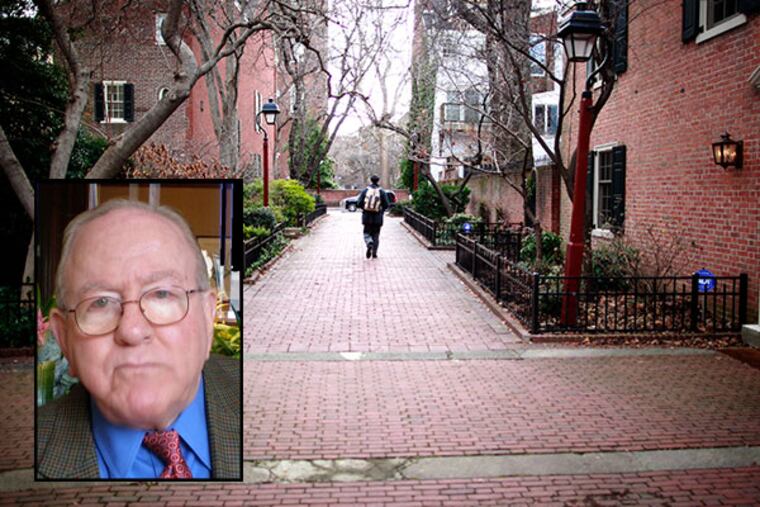
Jason R. Nathan, 84, a government official who oversaw the construction of public housing projects throughout the Northeastern United States during the 1960s, but also went out of his way to fund Society Hill's colonial-style lamp posts and brick sidewalks, died Tuesday, Dec. 17, of heart failure at a Haverford nursing home.
Mr. Nathan, who spent most of his adult life in Philadelphia, was running the mid-Atlantic office of the Department of Housing and Urban Development during the period when cities across the country were clear-cutting old neighborhoods and replacing them with cookie-cutter housing towers.
But when Philadelphia rejected the demolition of Society Hill for a more sensitive historic renovation, Mr. Nathan embraced the unconventional plan.
Mr. Nathan became so deeply invested in Society Hill's success, he came up with federal money to ensure that the sidewalks and public spaces would be finished in a compatible historic style. That money helped pay for St. Peter's Way, a charming pedestrian street that weaves through Society Hill.
"L&I wanted to do concrete sidewalks, but it was Jay who insisted on brick," recalled Walt D'Alessio, a real estate investor who was then head of the Redevelopment Authority. "He was a stickler for detail and design."
Although Mr. Nathan, who was born in Springfield, Mass., and graduated from Harvard Law School, was a top federal housing official, he was hardly a typical bureaucrat. He mingled with architects like Philip Johnson and was a guest at his famous Glass House in Connecticut.
In 1963, he began living in Philadelphia with his partner, Martin Hinkle, a landscape architect. It was a relationship that would last until Hinkle's death in 2008.
In 1966, Mr. Nathan briefly moved to New York City after its new mayor, John V. Lindsay, asked him to take over the city housing department, which was under pressure to address a severe shortage of affordable housing.
During the three years Mr. Nathan spent in New York - always commuting back to Philadelphia on the weekends - he began to advocate a more market-oriented approach to housing. Mr. Nathan launched mixed-use projects that began the rejuvenation of the Upper West Side and Tribeca.
But he faced resistance when he suggested loosening the city's tough rent-control laws and allowing rent increases as a way to keep New York landlords from abandoning their buildings.
The proposal was so controversial that Lindsay agreed during his reelection campaign in 1969 to replace Mr. Nathan. Praising the decision, the New York Times suggested that Mr. Nathan's "fiery rhetoric and flair for drama" had gotten him into trouble.
Returning to Philadelphia, Mr. Nathan took a job as head of Franklin Town Development Corp., a private redevelopment agency set up by pharmaceutical company Smith, Kline & French and others to rebuild a 50-acre area in the northwest quadrant of Center City, between Race and Spring Garden Streets.
The Franklintown master plan, which Mr. Nathan developed with Johnson in 1971, promised to repeat his success on New York's West Side. The plan, which envisioned a mini-city of new housing, offices, and a Lincoln Center-like theater complex, led to the reconfiguration of several streets - the reason 17th Street now makes an odd angled jog north of Vine.
Although Mr. Nathan did succeed in luring a major hotel to 16th and Vine (now a Sheraton) and completing several apartment towers, the Franklintown project is considered a failure. This year, the drug maker (now GlaxoSmithKline) left the area entirely for offices in the Navy Yard.
During the years Mr. Nathan worked for the government, he felt obliged to keep his relationship with Hinkle a secret, said Tom Wilson Weinberg, a composer and founder of Giovanni's Room, a gay bookstore on Pine Street. Mr. Nathan and Hinkle maintained separate phone numbers, and Hinkle never accompanied Mr. Nathan to HUD social events. But by the mid-'70s, "he began to feel comfortable with his gayness," Weinberg recalled.
Mr. Nathan's Society Hill home became a center of gay social life. He and Hinkle were known for hosting large dinners, especially on Thanksgiving. Mr. Nathan was "cranky and curmudgeonly, but also funny and generous, and his friends knew that," Weinberg said.
After leaving Franklin Town Development in the late '70s, Mr. Nathan became increasingly interested in the model that rescued Society Hill. He formed a development company that repurposed several historic buildings, including the Drexel Building at 15th and Walnut Streets and the Chateau Crillon apartments on Rittenhouse Square.
He also helped the Preservation Alliance establish its facade easement program, which has saved dozens of historic buildings by persuading owners to sign deed restrictions protecting the facades in perpetuity.
"He was a preservation-minded developer who loved the city," said Paul Steinke, a friend who runs the Reading Terminal Market.
Mr. Nathan is survived by a brother, Jerry Nathan, and his first cousin, Joyce Nathan Neumann.
A memorial service was being planned.
215-854-2213 @ingasaffron